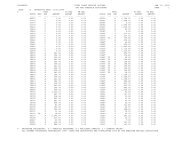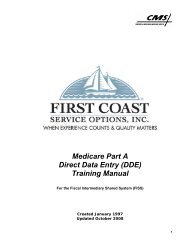Oct-Nov 00 Part A Bulletin - Medicare
Oct-Nov 00 Part A Bulletin - Medicare
Oct-Nov 00 Part A Bulletin - Medicare
Create successful ePaper yourself
Turn your PDF publications into a flip-book with our unique Google optimized e-Paper software.
LOCAL AND FOCUSED MEDICAL REVIEW POLICIES<br />
84484: Troponin<br />
Revision Overview—Additions and clarifications to further identify when a Troponin test is medically necessary were added<br />
to the “Indications and Limitations of Coverage and/or Medical Necessity” section of the policy.<br />
Policy Number<br />
84484<br />
Contractor Name<br />
First Coast Service Options, Inc.<br />
Contractor Number<br />
090<br />
Contractor Type<br />
Intermediary<br />
LMRP Title<br />
Troponin<br />
AMA CPT Copyright Statement<br />
CPT codes, descriptions, and other data only are<br />
copyright 1998 American Medical Association (or such<br />
other date of publication of CPT). All Rights Reserved.<br />
Applicable FARS/DFARS Apply.<br />
HCFA National Coverage Policy<br />
Program Memorandum AB 98-42<br />
Primary Geographic Jurisdiction<br />
Florida<br />
Secondary Geographic Jurisdiction<br />
N/A<br />
HCFA Region<br />
Region IV<br />
HCFA Consortium<br />
Southern<br />
Policy Effective Date<br />
11/02/1998<br />
Revision Effective Date<br />
08/10/2<strong>00</strong>0<br />
Revision Ending Effective Date<br />
08/09/2<strong>00</strong>0<br />
Policy Ending Date<br />
N/A<br />
LMRP Description<br />
Troponin is a muscle protein that attaches to both actin<br />
and tropomyosin. It is concerned with calcium binding and<br />
inhibiting cross-bridge formation. Troponin is a complex of<br />
three proteins: troponin C, troponin I, and troponin T. The<br />
distribution of these isoforms varies between cardiac muscle<br />
and slow- and fast-twitch skeletal muscle. Their importance<br />
lies in the fact that the isoforms troponin I and troponin T<br />
show a high degree of cardiac specificity, and therefore,<br />
have an important role in the diagnostic evaluation of a<br />
patient presenting with symptoms suggestive of a cardiac<br />
origin.<br />
Cardiac Troponin I (cTnI) is highly specific for<br />
myocardial tissue, is thirteen times more abundant in the<br />
myocardium than CK-MB on a weight basis, is not<br />
detectable in the blood of healthy persons, shows a greater<br />
proportional increase above the upper limit of the reference<br />
interval in patients with myocardial infarction and remains<br />
elevated for seven to ten days after an episode of myocardial<br />
necrosis. In addition, measurements of cTnI is useful to<br />
clarify which increases in CK-MB are due to myocardial<br />
injury and which ones reflect acute or chronic skeletal<br />
muscle abnormalities.<br />
Troponin T, the tropomyosin-binding protein of the<br />
regulatory complex located on the contractile apparatus of<br />
cardiac myocytes, is also a sensitive and specific marker for<br />
myocardial necrosis. Damaged heart muscle releases the<br />
protein, troponin T, which increases in the bloodstream as<br />
early as 3 hours after the onset of chest pain and remains at<br />
an elevated level for 2 to 7 days.<br />
Indications and Limitations of Coverage and/<br />
or Medical Necessity<br />
Troponin levels are considered medically reasonable<br />
and necessary to rule out myocardial injury only under the<br />
following conditions:<br />
• patient presents with signs and symptoms of an acute<br />
myocardial infarction (prolonged chest pain often<br />
described as squeezing, choking, stabbing, etc., usually<br />
spreading across chest to the left arm; dyspnea,<br />
diaphoresis) which is confirmed by an<br />
electrocardiogram (EKG, ECG);<br />
• patient presents with vague or atypical symptoms<br />
suggestive of a cardiac origin, which is not confirmed<br />
by an electrocardiogram;<br />
• patient evaluation reveals a normal creatine kinase MB<br />
isoenzyme (CK-MB), however, the EKG demonstrates<br />
new changes consistent with ischemia (e.g., flipped T<br />
waves, ST-segment depression); or<br />
• to distinguish patients with unstable angina from those<br />
with a non-Q wave myocardial infarction.<br />
Initially, it is expected that a qualitative Troponin level<br />
(procedure code 84512) is performed on a patient with<br />
suspected myocardial injury. If the results of the qualitative<br />
Troponin level is positive, then the quantitative level of<br />
Troponin I or Troponin T (procedure code 84484) is<br />
performed, usually with the same blood specimen, to<br />
determine if the symptoms are cardiac in nature. The<br />
Troponin C isoform is not useful in the management of<br />
myocardial infarction and it is not necessary to monitor both<br />
the T and I isoform.<br />
The quantitative test is normally performed every 8-12<br />
hours the first 24 hours. Once the determination is made<br />
whether myocardial injury has occurred, it is expected that a<br />
Troponin level will be performed only when the results are<br />
to be used in the active treatment of the patient.<br />
Also, it is not necessary to use Troponin in addition to<br />
Creatine Kinase (procedure codes 82550-82554) in the<br />
management of patients with myocardial infarction.<br />
30 The Florida <strong>Medicare</strong> A <strong>Bulletin</strong><br />
<strong>Oct</strong>ober/<strong>Nov</strong>ember 2<strong>00</strong>0





